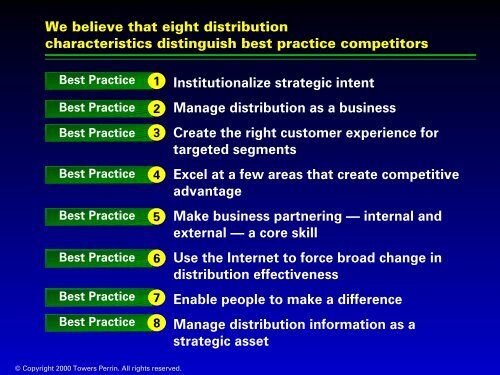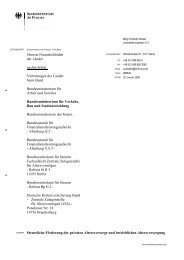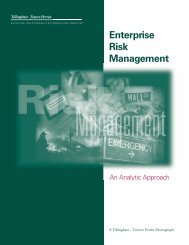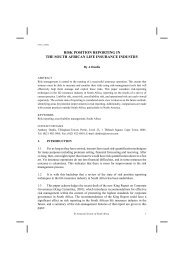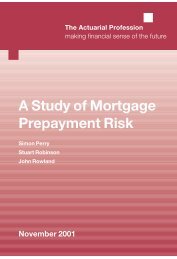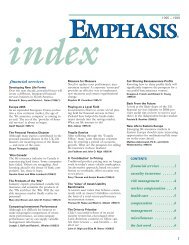management - Towers Perrin
management - Towers Perrin
management - Towers Perrin
You also want an ePaper? Increase the reach of your titles
YUMPU automatically turns print PDFs into web optimized ePapers that Google loves.
We believe that eight distribution<br />
characteristics distinguish best practice competitors<br />
Best Practice<br />
Best Practice<br />
Best Practice<br />
Best Practice<br />
Best Practice<br />
Best Practice<br />
Best Practice<br />
Best Practice<br />
© Copyright 2000 <strong>Towers</strong> <strong>Perrin</strong>. All rights reserved.<br />
1<br />
2<br />
3<br />
4<br />
5<br />
6<br />
7<br />
8<br />
Institutionalize strategic intent<br />
Manage distribution as a business<br />
Create the right customer experience for<br />
targeted segments<br />
Excel at a few areas that create competitive<br />
advantage<br />
Make business partnering — internal and<br />
external — a core skill<br />
Use the Internet to force broad change in<br />
distribution effectiveness<br />
Enable people to make a difference<br />
Manage distribution information as a<br />
strategic asset
Best Practice<br />
1<br />
Make the firm’s strategic intent<br />
meaningful at every level of the organization<br />
A well-defined<br />
strategic intent<br />
is consistently<br />
communicated<br />
© Copyright 2000 <strong>Towers</strong> <strong>Perrin</strong>. All rights reserved.<br />
Be the premier global<br />
retail financial services<br />
brand<br />
Empower individuals to<br />
become better investors;<br />
the Internet is the future<br />
for our customers<br />
Benefits<br />
Focuses on what is important<br />
Drives resource alignment and<br />
organization<br />
Bridges operational and<br />
<strong>management</strong> gaps<br />
Best practice firms institutionalize their<br />
strategic intent in their operating models and<br />
processes
Strategic intent is translated<br />
into detailed operating requirements that define<br />
how distribution activities are organized and managed<br />
© Copyright 2000 <strong>Towers</strong> <strong>Perrin</strong>. All rights reserved.<br />
Strategy Operating Requirements — Examples<br />
The Internet is the future for<br />
our customers<br />
We will sell directly to customers<br />
Small business is a key business<br />
of the company<br />
Operating Requirements to Implement<br />
■ Define how value created for the<br />
customer/firm<br />
■ Reset role of phone/branches<br />
■ Change pricing structure for new competition<br />
■ Redefine distribution roles/relationships<br />
■ Design new channel<br />
■ Expand functionality of call centers<br />
■ Reset role of the sales force<br />
■ Reset role of the branch sales force<br />
■ How quality will be delivered<br />
■ Design dedicated phone channel
Translating strategy into operating practice requires<br />
attention to the details of sales and service processes<br />
Operational Excellence — One Bank’s Approach<br />
Bank’s Perspective Operating Requirements<br />
We strive for accuracy, we fix mistakes<br />
We manage systematically<br />
We understand quality and how to<br />
improve it it<br />
We are “customer service engineers”<br />
© Copyright 2000 <strong>Towers</strong> <strong>Perrin</strong>. All rights reserved.<br />
Highly efficient problem resolution<br />
process<br />
Customer-centered process<br />
<strong>management</strong><br />
Customer satisfaction centered on<br />
specific sales/services experiences<br />
“Managing the quality and details of the sales and<br />
service processes will be a much more important job in<br />
the Retail Bank if if we are to deliver consistently on the<br />
value promise.” — CEO of a large U.S.<br />
bank
Sale<br />
Commission,<br />
Net Income<br />
Best Practice 2<br />
Distribution should be managed<br />
as a business with a distribution P&L<br />
180%<br />
Cumulative<br />
Value100<br />
Contribution<br />
Economic Contribution of Individual Branches<br />
© Copyright 2000 <strong>Towers</strong> <strong>Perrin</strong>. All rights reserved.<br />
Not all customers create value . . .<br />
40% of customers =<br />
180% of value<br />
Traditional measures may not<br />
align with economic contribution<br />
High performers are<br />
overpaid<br />
New recruits destroy<br />
value<br />
Low producers do not<br />
cover costs<br />
15% = 100% of value<br />
0%<br />
0% 40%<br />
% of Customers<br />
80%<br />
0<br />
+<br />
5% destroy<br />
40%<br />
of value<br />
Value-added analysis is a better metric<br />
Value<br />
New Intermediaries<br />
Value-added<br />
Existing Intermediaries<br />
Expected 100 50<br />
■ Recruitment<br />
■ Productivity<br />
■ Retention<br />
■ Expenses<br />
Actual<br />
(20)<br />
15<br />
15<br />
(5)<br />
105<br />
–<br />
10<br />
5<br />
(10)<br />
55
Key performance indicators<br />
for distribution generally must go<br />
beyond traditional measures of financial performance<br />
Primary Initiative Key Performance Factors<br />
New Store<br />
Manager<br />
Greater<br />
Investment<br />
Product Sales<br />
Vigorous Platform<br />
Sales<br />
Teller<br />
Effectiveness<br />
End-to-End Sales/<br />
Service Process<br />
Systematic Design/<br />
Management<br />
Satisfying<br />
Customer<br />
Experience<br />
© Copyright 2000 <strong>Towers</strong> <strong>Perrin</strong>. All rights reserved.<br />
Process/site audit<br />
Branch sales/growth<br />
Sales performance<br />
Sales volumes/revenues<br />
Cycle times<br />
Household penetration<br />
Customer satisfaction<br />
Employee/customer retention<br />
Productivity<br />
Cost to staff<br />
Turnover<br />
Teller retention<br />
Teller error rates<br />
Sales referrals<br />
Customer satisfaction/retention<br />
Sales productivity/efficiency<br />
Problem resolution metrics<br />
Cost of quality<br />
Site quality measures<br />
Site audit measures
A balanced scorecard that captures both<br />
results and the drivers of future performance<br />
strengthens focus and control of strategy implementation<br />
Revenue<br />
■ Growth<br />
from new<br />
business<br />
■ Growth<br />
from<br />
existing<br />
business<br />
Capacity<br />
■ Turnover<br />
ratio<br />
■ Availability<br />
rate<br />
© Copyright 2000 <strong>Towers</strong> <strong>Perrin</strong>. All rights reserved.<br />
Example: Retail Banking<br />
Financial Results Operational Excellence<br />
Sales/Service<br />
Efficiency<br />
■ Cost to<br />
sell/<br />
revenue $<br />
■ Cost to<br />
service<br />
Talent Management<br />
Franchise<br />
Growth<br />
■ Net growth in<br />
households<br />
■ Household<br />
penetration<br />
of investment<br />
products<br />
Sales/Service<br />
Productivity Effectiveness<br />
■ Revenue per<br />
sales person<br />
■ Transactions<br />
per service<br />
person<br />
■ % in top two<br />
performance<br />
ratings<br />
■ % meeting<br />
minimum<br />
requirements<br />
Process<br />
Quality<br />
■ Score on sales<br />
process<br />
■ Partner agreement<br />
scores<br />
Profitable<br />
Customers<br />
■ Percent of<br />
profitable<br />
customers<br />
■ Retention<br />
of new<br />
customers<br />
Customer Franchise<br />
Relationship<br />
Quality<br />
■ Product<br />
family crosssell<br />
ratio<br />
Quality<br />
Management<br />
■ Score on problem<br />
resolution<br />
process<br />
■ Cost of poor<br />
quality<br />
Customer<br />
Satisfaction<br />
■ Customer<br />
experience<br />
satisfaction<br />
■ Site rating
Best Practice<br />
A well-designed customer<br />
experience changes the basis<br />
of competition from<br />
product/price to total value<br />
© Copyright 2000 <strong>Towers</strong> <strong>Perrin</strong>. All rights reserved.<br />
3<br />
The essence of the distribution challenge is to deliver the right<br />
customer experience for targeted customer groups across all channels<br />
Recenter distribution to the Internet<br />
■ New added value, not self-service<br />
■ Integrated customer experience<br />
■ Reset functionality in other channels<br />
Benefits<br />
■ Complementarity of cross-channel<br />
customer experience<br />
■ Well-designed processes<br />
■ Complementary functionality in all<br />
channels<br />
■ Few master the requirements for distinctive customer experience<br />
■ Process design and vigorous <strong>management</strong> are first steps<br />
■ Reducing variation* across sales experiences builds customer<br />
confidence, improves efficiency, reduces the cost of poor quality and<br />
improves sales effectiveness<br />
* Frei, F.X., Harker, P.T., and Hunter L. (1999), “Process Performance and Customer Satisfaction: Evidence from Retail Banking<br />
Study,” Working Paper, The Wharton Financial Institutions Center, The Wharton School, University of Pennsylvania (Philadelphia, PA).
Financial services firms increasingly use<br />
the characteristics of individual channels to craft the<br />
dimensions of customer experience specific to their strategy<br />
© Copyright 2000 <strong>Towers</strong> <strong>Perrin</strong>. All rights reserved.<br />
■ Highest-skilled financial advisers “in sites” for<br />
high net worth customers<br />
■ Single level of service over the phone<br />
■ Segmented service levels via phone<br />
■ Highly individualized service over the web<br />
■ Homogeneous service in the sites<br />
■ Homogeneous service in traditional sites<br />
■ Streamlined services for in-store sites<br />
■ Specialized services in designated sites (e.g.,<br />
Business Banking)<br />
■ Segment-specific phone channels
American<br />
Express<br />
CapOne<br />
Fidelity<br />
LendingTree<br />
Merrill Lynch<br />
Schwab<br />
Wal-Mart<br />
Wells Fargo<br />
Best Practice<br />
Our research shows best practice firms excel in a few areas that<br />
create competitive advantage specific to the firm and its strategies<br />
Planning Channels Sales Fulfillment CRM Scorecards<br />
■ Brand strategy<br />
■ Resource<br />
allocation<br />
■ Enterprise<br />
goals<br />
■ ROI<br />
X<br />
X<br />
X<br />
X<br />
■ Cross-channel<br />
■ Alignment<br />
■ Operating<br />
models<br />
■ Innovation<br />
■ Partners<br />
© Copyright 2000 <strong>Towers</strong> <strong>Perrin</strong>. All rights reserved.<br />
4<br />
X<br />
X<br />
X<br />
X<br />
The Distribution Value Chain<br />
■ Sales<br />
processes<br />
■ Enabled<br />
staff<br />
■ Sales platform<br />
■ Value<br />
proposition<br />
X<br />
X<br />
X<br />
X<br />
X<br />
X<br />
■ Response time<br />
■ Follow-up<br />
■ Partner<br />
standards<br />
■ Relationship<br />
<strong>management</strong><br />
■ Share of of wallet<br />
■ Customer<br />
experience<br />
■ Learning<br />
capture<br />
■ Evaluation<br />
■ Business<br />
system<br />
changes<br />
Best practice firms carefully evaluate root causes of of performance gaps<br />
to to realign resources and strengthen execution capabilities<br />
X<br />
X<br />
X<br />
X<br />
X<br />
X<br />
X<br />
X<br />
X<br />
X<br />
X
Best practices firms finely tune<br />
investments in distribution capabilities: disinvest,<br />
continuously improve, or build/restructure to grow<br />
■ Managing to the requirements of each capability ensures<br />
resources are invested efficiently<br />
Organizational<br />
Performance<br />
Superior<br />
Parity<br />
Deficient<br />
© Copyright 2000 <strong>Towers</strong> <strong>Perrin</strong>. All rights reserved.<br />
Surplus<br />
Capabilities Assessment<br />
Aligned<br />
Gaps<br />
To play To compete To win<br />
Distribution Importance<br />
Too much<br />
investment<br />
Protect<br />
investment<br />
Restructure<br />
Difficulty to<br />
remedy:<br />
High<br />
Medium<br />
Low
Best Practice<br />
5<br />
Business partnering — internal and<br />
external — is a core skill for the distribution organization<br />
■ External partners can improve the firm’s value proposition<br />
These are not traditional outsourcing<br />
relationships — they are strategic partnerships<br />
© Copyright 2000 <strong>Towers</strong> <strong>Perrin</strong>. All rights reserved.<br />
■ Distribution relationships — KeyCorp, First Union<br />
■ FA network<br />
■ Washington Mutual — annuities/insurance products<br />
■ JP Morgan — IPO product<br />
■ Stock trading network — Schwab and others<br />
■ Merrill Lynch/Lehman — research<br />
■ Schwab — mutual funds distribution<br />
■ Internet site — Fingerhut/Books-A-Million<br />
■ Extraordinarily strong vendor relationships to manage<br />
inventory turn and financing costs
Internal partnering agreements are important in<br />
delivering the targeted customer experience profitably<br />
■ Multichannel, multiproduct distribution requires more<br />
disciplined <strong>management</strong> practices within and across lines of<br />
business<br />
■ Win-win partnerships create value for internal and external<br />
partners<br />
Business Goals<br />
■ Partner’s value added for<br />
distribution<br />
■ How value of partnership is<br />
measured<br />
■ Expected roles ⎯ planning,<br />
execution, evaluation, reporting<br />
© Copyright 2000 <strong>Towers</strong> <strong>Perrin</strong>. All rights reserved.<br />
Distribution Internal<br />
Partner Requirements<br />
Financial, brand, strategic contributions<br />
Metrics for assessing value of partnership<br />
for both partners<br />
Specificity regarding roles in creating value<br />
■ Knowledge capture Key areas of distribution value chain where<br />
knowledge will be captured
Best Practice<br />
Firms’ ongoing efforts to remake or improve distribution<br />
must be carried out while adding Internet advantages and options<br />
Internet<br />
© Copyright 2000 <strong>Towers</strong> <strong>Perrin</strong>. All rights reserved.<br />
6<br />
■ New business models and cross-LOB thinking<br />
■ Economic results are in the future; expenses are<br />
immediate<br />
■ Traditional channels have new roles while<br />
delivering on old roles more efficiently<br />
■ New cross-LOB integration for promotion/cross-sell<br />
■ Redesign customer information systems for cross-LOB<br />
leverage<br />
■ Same quality customer experience on web/phone<br />
■ Remake the operating model for the sites<br />
■ Center differentiated service levels on the phone<br />
■ Manage economic impact of new web-induced trading<br />
pricing
Best Practice 7<br />
Enable people to use distribution investments to<br />
make a difference in performance and competitiveness<br />
■ Align organization, total reward programs, sales and service<br />
processes and the firm’s culture to enhance customer satisfaction and<br />
sales effectiveness<br />
■ Align human resource systems — organization, job design, selection,<br />
training and total rewards — to the distribution strategy<br />
Process<br />
■ The design and efficiency of:<br />
■ Sales and service<br />
■ Customer problem solving<br />
■ Customer referrals and<br />
hand-offs<br />
© Copyright 2000 <strong>Towers</strong> <strong>Perrin</strong>. All rights reserved.<br />
Structure<br />
■ Organization of key resources<br />
■ Clear roles<br />
Culture<br />
■ What motivates performance<br />
■ Sales and service values<br />
■ Guiding principles<br />
Technology<br />
■ Knowledge <strong>management</strong><br />
system<br />
People<br />
■ Skills<br />
■ Job design<br />
■ Selection<br />
■ Training<br />
■ Rewards and recognition
Best Practice 8<br />
Manage distribution information as a<br />
strategic asset of significant current and future value<br />
■ Using the right information to improve performance and competitiveness<br />
requires careful integration into business and operating models<br />
■ Best practice firms reinforce the key elements of their strategy to enhance<br />
competitive advantage<br />
© Copyright 2000 <strong>Towers</strong> <strong>Perrin</strong>. All rights reserved.<br />
Be ready to sell when the customer invites you into his/her space<br />
■ 60% – 70% chance they know why customer is calling<br />
■ Skills-based routing<br />
■ 24 pieces of information on the customer at the point of sale<br />
■ Alternative offers “whispered” to the CSR<br />
CVM tools can help maximize value and opportunity<br />
% change<br />
in deposits<br />
100%<br />
50%<br />
0%<br />
Price Elasticity<br />
0% 40% 80%<br />
% change in rates relative to competition<br />
On On a $10B portfolio, a 5bp 5bp rate rate increase can can add add $5M $5M to to the the bottom line line<br />
Price opportunistically<br />
by identifying pockets<br />
of price indifference


